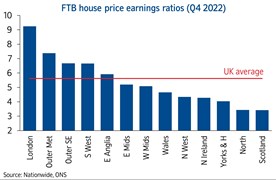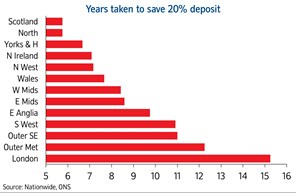 Annual house price growth has slowed further, dropping to 1.1% in January, from 2.8% in December, according to latest Nationwide House Price Index.
Annual house price growth has slowed further, dropping to 1.1% in January, from 2.8% in December, according to latest Nationwide House Price Index.
Moreover, January saw a further monthly price fall (-0.6%), which left prices 3.2% lower than their August peak – after taking account of seasonal effects.
| Headlines | Jan-23 | Dec-22 |
|---|---|---|
| Monthly Index* | 523.4 | 526.5 |
| Monthly Change* | -0.6% | -0.3% |
| Annual Change | 1.1% | 2.8% |
| Average Price
(not seasonally adjusted) |
£258,297 | £262,068 |
* Seasonally adjusted figure (note that monthly % changes are revised when seasonal adjustment factors are re-estimated)
But there are some encouraging signs that mortgage rates are normalising, although it is too early to tell whether activity in the housing market has started to recover, according to Robert Gardner, Nationwide’s chief economist.
He said: “The fall in house purchase approvals in December reported by the Bank of England largely reflects the sharp decline in mortgage applications following the mini-Budget.
“It will be hard for the market to regain much momentum in the near term as economic headwinds are set to remain strong, with real earnings likely to fall further and the labour market widely projected to weaken as the economy shrinks.
“As we highlighted in our recent affordability report, the biggest change in terms of housing affordability for potential buyers over the last year has been the rise in the cost of servicing the typical mortgage as a result of the increase in mortgage rates.
“Should recent reductions in mortgage rates continue, this should help improve the affordability position for potential buyers, albeit modestly, as will solid rates of income growth (wage growth is currently running at around 7% in the private sector), especially if combined with weak or negative house price growth.
“Nevertheless, the overall affordability situation looks set to remain challenging in the near term. Saving for a deposit is proving a struggle for many given the rising cost of living, especially those in the private rented sector where rents have been rising at their strongest pace on record (on data extending back to 2005 for England).
“High house prices relative to earnings mean deposit requirements remain a major challenge. Moreover, the Help To Buy Equity Loan scheme that helped those with a smaller deposit buy a new build property is due to end in March. However, the government’s mortgage guarantee scheme, which helps to secure the availability and lower the cost of higher loan-to-value mortgages, has been extended until the end of 2023.
All regions have seen a deterioration in affordability compared to 2021, with the cost of servicing the typical mortgage as a share of take-home pay now at or above the long-run average in all regions.
Affordability pressures remain particularly acute in London and the south of England, where mortgage servicing costs have risen sharply compared with a year ago. Scotland and the North continue to be the most affordable regions but, even there, mortgage payments as a share of take-home pay are at their highest level for over a decade.
Gardner added: “There continues to be a significant gap between the least affordable and most affordable regions, although this has remained broadly stable over the last year. London continues to have the highest house price to earnings ratio at 9.2, but this is still below its record high of 10.2 in 2016.
“Scotland and the North region have the lowest house price to earnings ratios at 3.4. Over the longer term, Northern England and Scotland have historically seen lower HPERs than Southern England, Wales and Northern Ireland.
“But there is substantial regional variation, as illustrated below, which shows the average time it would take someone earning the typical wage in each region to save a 20% deposit towards an average FTB property, assuming they set aside 15% of their take-home pay each month.”
Industry reactions:
Nathan Emerson, chief executive of Propertymark:
“January has kicked off the New Year with a boom according to many of our estate agent members. They have seen a rise in homes coming to the market and plenty of keen sellers present.
“Buyers are cottoning onto the fact that purchasing power is now in their hands due to competition levels easing for the first time in a while. Therefore, it is unsurprising that the average house price continues to fall as buyers tighten their purse strings and, in some cases, look for slightly smaller, more cost-effective homes than before.”
Matthew Thompson, Head of Sales at Chestertons, says: “2023 unfolded with a busy property market which is being boosted by house hunters who paused their search due to last year’s economic uncertainty but no longer want to delay their search.
“In January, our branches noticed a 25% increase in viewings compared to January last year. Whilst buyer demand is strong, the number of market appraisals remains comparably low as some sellers are still observing how the market might be developing in the first quarter of this year. Sellers who are currently listing their property are therefore in a stronger position to attract serious buyers and offers.”
Matthew Thompson, head of sales at Chestertons:
“2023 unfolded with a busy property market which is being boosted by house hunters who paused their search due to last year’s economic uncertainty but no longer want to delay their search.
“In January, our branches noticed a 25% increase in viewings compared to January last year. Whilst buyer demand is strong, the number of market appraisals remains comparably low as some sellers are still observing how the market might be developing in the first quarter of this year. Sellers who are currently listing their property are therefore in a stronger position to attract serious buyers and offers.”
Tom Bill, head of UK residential research at Knight Frank:
“The UK housing market is headed for an annual fall in prices as mortgage rates remain notably higher than 12 months ago. To anticipate how steep, you need to look beyond the short-term distortion of the mini-Budget. For example, buyers and sellers switched off early for Christmas but activity bounced back in January.
“The resilience of prices and sales volumes will be put to the test in the spring when larger numbers of transactions take place and by which time virtually no five-year fixed-rate mortgages below 4% will remain in circulation. We expect prices to decline 10% over the next two years as budgets get recalculated.”
James Forrester, MD of Barrows and Forrester:
“Home sellers are continuing to secure a very good price in current market conditions and it’s important to remember that although house prices have started to cool, they remain there or thereabouts when compared to the meteoric highs of the pandemic market boom.
So not only is the current correction very much a return to market normality, it’s fair to say that this return is taking far longer than predicted as the market continues to defy wider expectations against what are otherwise strong economic headwinds.”
Chris Hodgkinson, MD of House Buyer Bureau:
“While the market remains fairly strong, we can expect the herd mentality of the nation’s homebuyers to continue to dampen house price growth.
“During the pandemic boom, homebuyers were falling over themselves to offer above the odds to secure a home. This tide has very much turned and while there remains a robust level of market activity, we’re seeing a more reserved approach during the negotiation stage.
“As a result, the nation’s sellers are meeting in the middle and accepting a slightly lower price for their home, but this is very much a market correction rather than a slippery slope of house price depreciation.”
Marc von Grundherr, director of Benham and Reeves:
“The decline in house prices seen in recent months is more akin to the market tripping over its shoelace than falling off a cliff edge and we’ve simply not seen the catastrophic property market decline that was so widely predicted during the latter stages of last year.
“Yes, buyers are treading with caution and sellers are having to adjust their price expectations in line with this changing market, but our appetite for homeownership remains strong and we continue to see activity despite wider economic turbulence.”




I do wish that Nationwide would publish exactly what their figures are based on. I’m assuming it’s based on mortgages completed as that would be logical for a bank or building society. That being the case then these price drops are around 4 months old and take into account any of their surveyors’ down-valuations. If they’re based on new applications then the statement about prices falling in January would be more accurate. Anyone know?
You must be logged in to like or dislike this comments.
Click to login
Don't have an account? Click here to register
I make a fall of 262k to 258k to be more like 1.5% than 0.6%? If I’m confused by this, its no wonder the public don’t know if prices are rising, static or falling.
You must be logged in to like or dislike this comments.
Click to login
Don't have an account? Click here to register